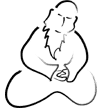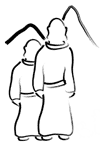On The Way: The Daily Zen Journal
Cultivating the Empty Field – Practice Instructions Part 3
Hongzhi (1091-1157)
The Amazing Living Beings
 Our house is a single field, clean, vast, and lustrous, clearly self-illuminated. When the spirit is vacant without conditions, when awareness is serene without cogitation, then buddhas and ancestors appear and disappear transforming the world.
Our house is a single field, clean, vast, and lustrous, clearly self-illuminated. When the spirit is vacant without conditions, when awareness is serene without cogitation, then buddhas and ancestors appear and disappear transforming the world.
Amid living beings is the original place of nirvana. How amazing it is that all people have this but cannot polish it into bright clarity. In darkness un-awakened, they make foolishness cover their wisdom.
One remembrance of illumination can break through and leap out of the dust of kalpas. Radiant and clear white, the single field cannot be diverted or altered. Solitary glory is deeply preserved, enduring throughout ancient and present times, as the merging of sameness and difference becomes the entire creation’s mother.
This realm manifests the energy of the many thousands of beings, all appearances merely this field’s shadows. Truly embody this reality.
The Conduct of the Moon and Clouds
The consistent conduct of people of the Way is like the flowing clouds with no grasping mind, like the full moon reflecting universally, not confined anywhere, glistening within each of the ten thousand forms.
 Dignified and upright, emerge and make contact with the variety of phenomena, unstained and unconfused. Function the same toward all others since all have the same substance as you. Language cannot transmit this, speculation cannot reach it. Leaping beyond the infinite and cutting off the dependent, be obliging without looking for merit.
Dignified and upright, emerge and make contact with the variety of phenomena, unstained and unconfused. Function the same toward all others since all have the same substance as you. Language cannot transmit this, speculation cannot reach it. Leaping beyond the infinite and cutting off the dependent, be obliging without looking for merit.
This marvel cannot be measured with consciousness or emotion. On the journey accept your function, in your house please sustain it. Comprehending birth and death, leaving causes and conditions, genuinely realize that from the outset your spirit is not halted. So we have been told that the mind that embraces all the ten directions does not stop anywhere.
Hongzhi Zhengjue (1091-1157)
Excerpted from Cultivating the Empty Field; The Silent Illumination of Zen Master Hongzhi” translated by Taigen Daniel Leighton and Yi Wu
The silent illumination that Zen Master Hongzhi expounds is both a form of sitting meditation practice and an orientation to a spiritual way of life. His meditation instructions do not specify yogic postures or rituals such as would have been familiar to his students at the temple where he taught.
Instead his writings display the many facets of the universally available experience of non-dual objectless meditation and the endless refinements and attunements involved in living out this awareness.
Most traditional meditation, both Buddhist and non-Buddhist, consists of concentration on specific objects such as visual images, sounds, breathing, concepts, stories, or deities in order to develop heightened states of concentrated awareness called samadhi.
Silent illumination, however, involves withdrawal from exclusive focus on a particular sensory or mental object to allow intent apprehension of all phenomena as a unified totality.
As Hongzhi emphasizes, the entire practice rests on the faith, verified in experience, that the field of vast brightness is ours from the outset. Silent illumination is thus fully experienced in meditative contemplation, and then naturally expressed in sincere compassionate behavior in the world.




There are few teachers who use imagery of the natural world as profoundly as Hongzhi to expound the Dharma.
Like clouds finally raining, like moonlight following the current, like orchids growing in shade, like spring arising in everything, people of the Way act without mind, they respond with certainty.
With evocative ease we enter a world of interconnectedness of all beings and realize the naturalness of Buddha nature. If we are to search closer in time we might read:
It was high on the shoulder of the mountain, within a beautiful mixed stand of conifers that delineated the entire scene, for they stood at the farthest edge of sight in every direction. They stood like sentries surrounded by a vast openness, an emptiness that acted upon all that it enclosed. Overhead, the openness was omnipresent and fell and purified the mind, cleansed it of the world far below.
The lake reflected it all clearly like a mirror. There was no wind to ruffle the tranquil glasslike surface. When the surface becomes ruffled, it cannot affect the hidden depths but still there is distortion, and the images of pure, cool mountains are broken into shattered fragments.
The mind seems to become murky and ceases to reflect faithfully when it holds onto even one of the myriad things that are forever passing peacefully through. Even the difficulties and the pains come and go peacefully if you let them. Don’t dwell in the distorting ripples of memory and imagination, but always return to the still point of the present. Let things be just the way they are.
– from Journeys on Mind Mountain
Learning from Nature,
Elana, Scribe for Daily Zen